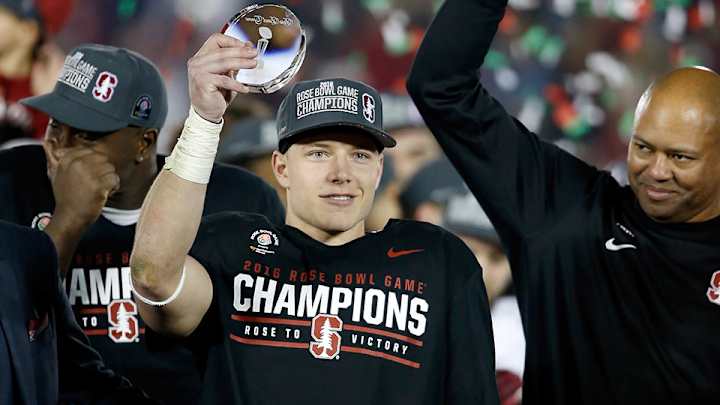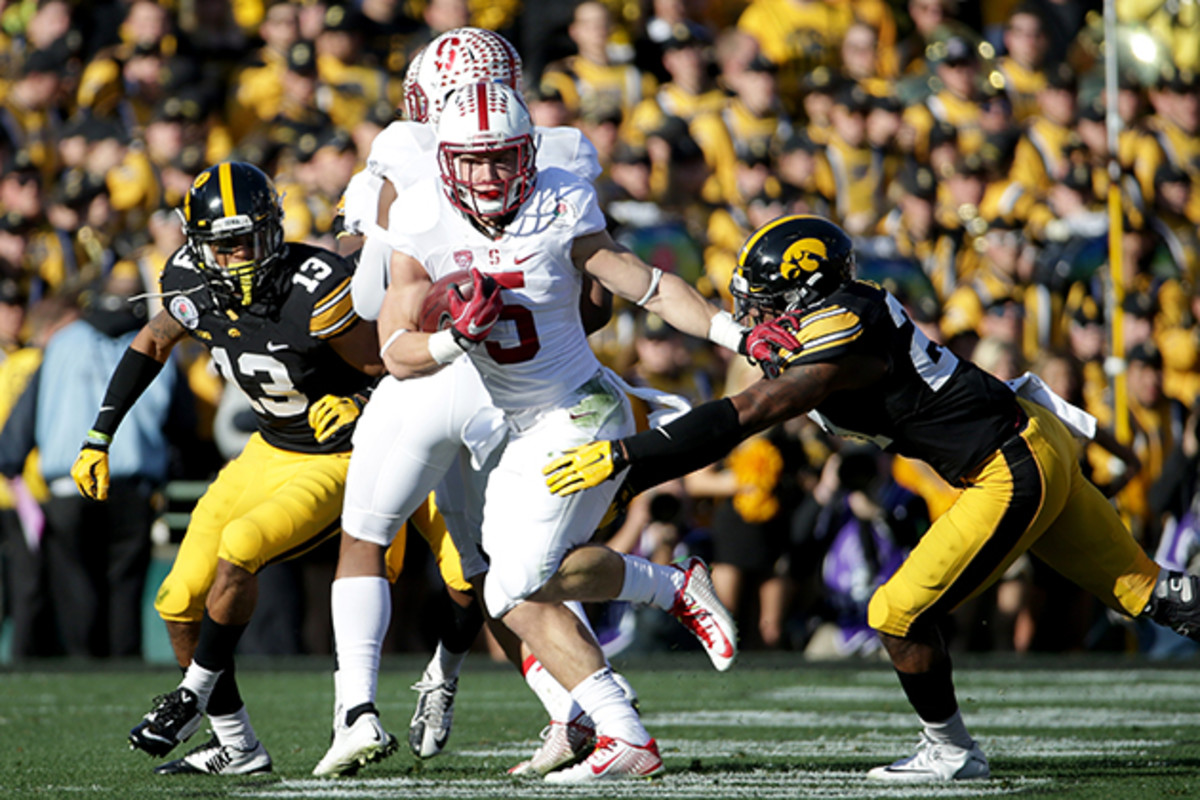Take note, NCAA: McCaffrey, Shaw lead Stanford in Rose Bowl walkover

Let’s get the score out of the way, because it was the least interesting part of the Rose Bowl. Stanford obliterated Iowa 45–16 on Friday in a game that was practically decided when the honorary coin showed Stanford’s logo and gave it the option to receive the football.
So we’ll take a couple minutes and a handful of paragraphs to discuss Christian McCaffrey, the star, before discussing David Shaw, the coach the NCAA should feature in any public relations campaign.
Start with McCaffrey: The Heisman runner-up finished with 368 all-purpose yards, a Rose Bowl record, and turned in the best performance in any bowl game this year and one of the most stupendous individual efforts in recent college football memory. He broke the single-season school rushing record and became the first player to both rush and receive for 100 yards in the Rose Bowl.
McCaffrey breaks Rose Bowl record with 368 all-purpose yards
First it was his acceleration on display, juking Iowa safety Jordan Lomax, snatching Kevin Hogan’s pass on a crossing route and zooming past a host of helpless Iowa defenders for a 75-yard touchdown on the game’s first play from scrimmage. 7–0.
Then it was his agility, carefully reading his blocks and snaking through holes for 19 yards, then 22, then 12 more. The Iowa defense keyed on him so intently that it forgot about quarterback Hogan, who jogged into the end zone for an eight-yard touchdown. 14–0. A pick-six by freshman defensive back Quinton Meeks, possibly Stanford’s next budding star, nullified any thought of Iowa coming back. 21–0.
All attention was now focused on what McCaffrey could accomplish in the remaining 49 minutes of game time. He answered that when he fielded an Iowa punt on the first play of the second quarter.
Two steps left, cut—two Iowa defenders fly by.
Stutter step, three more steps left—three more Hawkeyes go soaring past.
Five more steps left. One-two! Another cut. Poor Josey “The Outlaw” Jewell, Iowa’s best linebacker, finds himself on his rear.
28–0.
He later took a handoff 73 yards for another score, only to be nullified by a hold on the sidelines. The team in the yellow pants couldn’t do anything to stop him, but a yellow flag could. Tired yet? So was the Iowa defense.

McCaffrey’s legs churn like pistons, the revolutions so quick they appear to bend light, only visible by tapping a touch-pad mouse multiple times per second (pause, play, pause, play) to see when his feet actually touch the ground. After the sophomore finished his 248-yard first half (where he averaged 20.7 yards per touch), ESPN analyst Kirk Herbstreit marveled that the true sophomore would be the “face of college football next season.” Between McCaffrey and LSU running back Leonard Fournette, whose rare blend of speed and power mirrors Adrian Peterson the way McCaffrey’s agility and slipperiness resembles electric playmakers of years past like Reggie Bush and Peter Warrick, college football has two identifiable superstars to give it momentum into the 2016 season.
Christian McCaffrey is the glitz, the kind of budding young star who assures college football remains a multi-billion dollar enterprise. Tepid television ratings proved that casual fans weren’t interested in altering their New Year’s Eve plans to tune into the playoff games, but they may have been more inclined if a player like McCaffrey were lining up. What the playoff games lacked, excluding Alabama’s Derrick Henry, were the transcendent types. Clemson’s Deshaun Watson, Oklahoma’s Baker Mayfield and Alabama’s Reggie Ragland impress serious college football fans and may star in the NFL one day, but they don’t don’t make casual viewers giddy.
• WATCH: Stanford’s McCaffrey scores twice in first half of Rose Bowl
The youth, promise and electricity of players like McCaffrey add to the tradition and pageantry that sustain college football. But as the dollars get bigger and the public is gradually enlightened to the swaths of cash that run an ‘amateur’ sport, calls may get louder for players like McCaffrey to get paid.
Which is why the NCAA needs more than a star like McCaffrey, whose eligibility will one day expire like all of his predecessors.
What it needs is to prominently feature Shaw, McCaffrey’s head coach.
10 reasons to be excited for the Alabama-Clemson title game
Shaw may not have the schematic brilliance of Urban Meyer, the experience and wisdom of Nick Saban nor the innovative ambitions of Chip Kelly, but he has cultivated the depth, playing style and image that the best college coaches yearn for. He may have been gifted McCaffrey, whose parents were Stanford athletes in the late 1980s, but McCaffrey’s numbers likely aren’t as gaudy if he weren’t running behind four senior starters on one of the nation’s best offensive lines—all of whom were recruited by Shaw.
He lost one of the best college quarterbacks of this generation (Andrew Luck) after his first year in charge and his star young defensive coordinator (Derek Mason) to Vanderbilt a year later. Hounded by the narrative his success should be attributed to the work of Jim Harbaugh, Shaw has led the Cardinal to three Rose Bowls and one Fiesta Bowl in five years as Stanford head coach. He’s reached three Rose Bowls in four years. Before his arrival, Stanford had reached the Rose Bowl three times in 41 years.
Lest you think it was solely McCaffrey who led the Cardinal over Iowa, mind that Stanford sacked Iowa quarterback C.J. Beathardseven times. The team’s defensive line is usually as menacing and ferocious as its highly regarded offensive line. The Cardinal have boasted a couple of strong offensive skill players during Shaw’s tenure (Luck, Ty Montgomery), but his greatest accomplishment has been how well he has established depth in the trench positions. McCaffrey is the star, but Shaw has lured a host of potential NFL talent (Peter Kalambayi, Austin Hooper, Bryce Love, Josh Garnett, Quinton Meeks) to Palo Alto instead of traditional college football powerhouses.
Part of Shaw’s appeal is his gravitas, a stark departure from Harbaugh’s ruddy-faced sideline hollering, which played well with his players but less so with the classically buttoned-up donor base. While Harbaugh’s strategic tantrums and bulging eyes made for good Internet content and injected needed vigor into a downtrodden program, the extent of Shaw’s anger is the occasional flick of his wrist to dispute a call. Sideline demeanor is meaningless in evaluating the skill of a coach, but Shaw’s permanent calm has attracted several of the nation’s finest recruits to play at Stanford, a school with little local fan support, a sleepy gameday experience and a power offense structured around running the football in an era of spread offenses and flashy point totals.
More than just a game manager: Jake Coker ignites Alabama's playoff rout
What Shaw has is what the NCAA loves and needs at a time when the foundation of college football is cratering under a leaky legal defense. Shaw maintains the ability to sell Stanford to recruits the way no other coach can sell his school. He’s maintained the best graduation rate in the Pac-12 (it’s annually above 95%) and has put more players in the NFL during his five-year tenure than any other school in the conference. Somehow, he’s been the lone coach to uphold the NCAA’s arcane definition of "amateurism" in college football when the rest of the world has accepted that it’s a big business where the goal is to win games first, graduate kids second. That’d be impressive if he were winning eight games a year. Instead, he’s winning Rose Bowls.
Most attentive college football fans roll their eyes when the NCAA espouses a "scholarship" as currency when your standard FBS player commits some 30-plus hours to football every week during the season, leaving little time for homework. Shaw has publicly stated that he does not support the idea of paying players, but when he says it, it’s because the system is succeeding under his watch. Garnett, who won the Outland Trophy for the nation’s top interior offensive lineman, is a human biology major who is doing stem cell research. Maybe only Stanford can do this, but that’s all the NCAA needs.
• NIESEN: Fiesta Bowl win marks end of era for generation of Ohio State stars
At Stanford, the NCAA’s naive and false narrative functions properly. It’s why the NCAA should never run a PSA without Shaw and that year’s star Stanford player.
Whether it’s the cerebral approach of Luck, the humility of McCaffrey or the confidence of Richard Sherman, Stanford’s ability to place visible players into the limelight and impress mass audiences on the field and behind the microphone should not go unnoticed by its athletic overlord. Several people blame West Coast kickoff times as a reason McCaffrey didn’t win the Heisman Trophy this season. If the NCAA wants an opportunity to showcase one of the game’s best talents as well as free public relations for why its outdated model ‘works,’ then it’d be smart for the networks and conferences to get Stanford out of those 10:30 Eastern time slots and into primetime, which is typically occupied by the college football machines and the SEC. McCaffrey alone will make up for the ratings sacrifice of not broadcasting a more nationally prominent team next season. After that, it may be Love or Trent Irwin or whomever Shaw coaches into the next Stanford star.
McCaffrey spent New Year’s afternoon reminding college football fans—casual and serious—why they love nursing their hangovers and bringing in the New Year with college football. Shaw is the master who has cultivated one of the nation’s best programs under a system that doesn’t work for almost every other program. With the NCAA possibly wheezing its dying breaths before it inevitably has to pay college players, it should put Stanford front and center to try and stem the tide.
